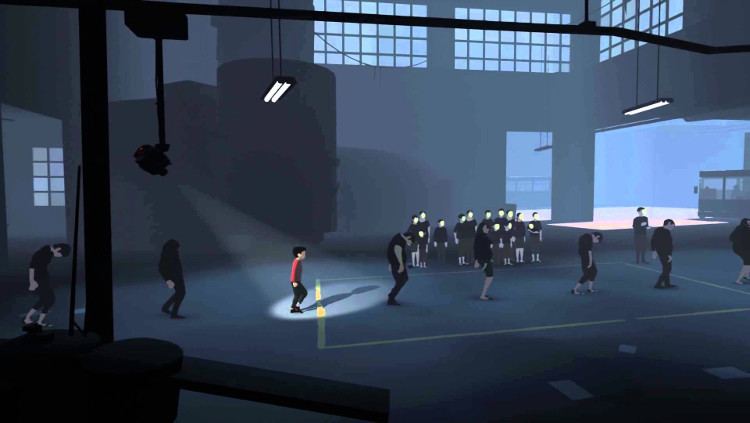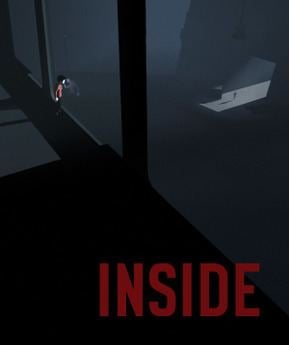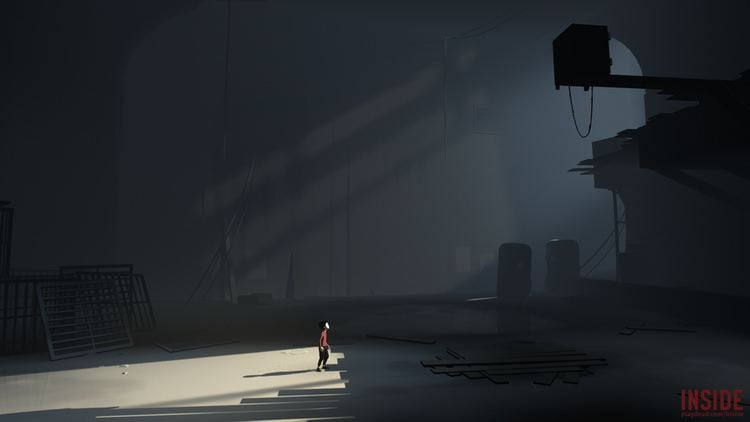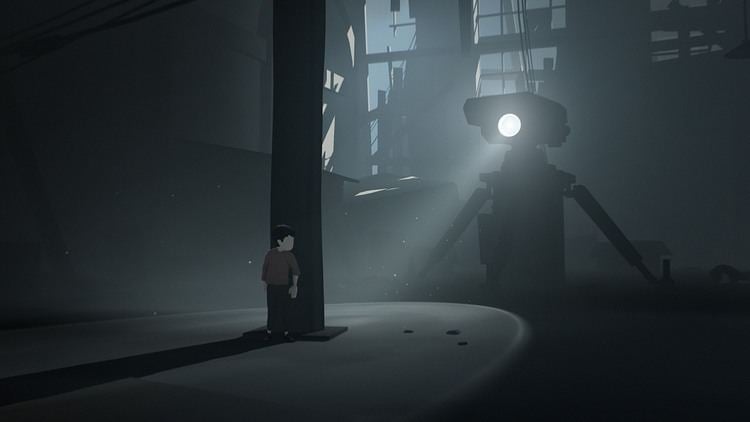9.4 /10 1 Votes
8/10 GameSpot Publisher(s) Playdead Designer(s) Jeppe Carlsen Developer Playdead | 10/10 Steam 10/10 IGN Director(s) Arnt Jensen Initial release date 29 June 2016 | |||||||||||||||||||||||||||||||||
 | ||||||||||||||||||||||||||||||||||
Producer(s) Dino Christian Patti
Mads Wibroe
Forest Swartout Large Programmer(s) Mikkel Svendsen
Mikkel Gjøl
Thomas Krog
Lasse Jon Fuglsang Pedersen
Søren T. Madsen Artist(s) Morten C. Bramsen
Jeremy Petreman
Marek Bogdan Awards The Game Award for Best Independent Game, The Game Award for Best Art Direction Platforms PlayStation 4, Xbox One, Microsoft Windows Genres Platform game, Adventure game Nominations The Game Award for Game Of The Year Similar Limbo, Firewatch, The Witness, ABZÛ, We Happy Few | ||||||||||||||||||||||||||||||||||
Inside (stylized as INSIDE) is a puzzle-platformer adventure video game developed and published by Playdead and first released in June 2016. In the game, the player controls a young boy in a dystopic world, solving environmental puzzles while avoiding death in a 2.5D sidescrolling fashion, thematically and visually following up on the 2010 monochromatic video game Limbo.
Contents

Playdead started working on Inside shortly after the release of Limbo. Initially, the company started with the same custom game engine they used for Limbo, but later switched to Unity to simplify development. They developed rendering routines to give the game a signature look and which they later released as open source. The game was partially funded by a grant from the Danish Film Institute.

Inside premiered at Microsoft's E3 2014 conference, with a planned release in 2015. The game was released for Xbox One on 29 June 2016, Microsoft Windows on 7 July, and for the PlayStation 4 on 23 August. The game received critical acclaim upon release, with some critics and reviewers calling it a worthy successor to Limbo.

Gameplay

Inside is a puzzle platformer in which the player character is an unnamed young red-shirted boy who explores a surreal environment presented as a primarily monochromatic 2.5D platform game, using color only to highlight parts of the environment. The game is very dark in nature and mostly silent, with only occasional musical cues. The player controls the boy who walks, runs, swims, climbs, and uses objects to overcome obstacles and progress in the game. Later the boy gains the ability to control bodies to complete certain puzzles, a mechanic that IGN's Marty Sliva compared to a similar mechanic in The Swapper. At various points in the game, the player may discover hidden rooms containing glowing orbs. If all the orbs are deactivated during a playthrough, the player can unlock the game's alternate ending.
The boy can die in various ways, such as being shot with a tranquilizer dart, mutilated by dogs, ensnared by security machines, blown apart by shockwaves, or drowning. As in the predecessor game Limbo, these deaths are presented realistically and are often graphic. If the character dies, the game continues from the most recent checkpoint.
Plot
A nameless red-shirted boy slides down a rocky incline. While running through a forest, he encounters masked guards with flashlights, as well as vehicles with mounted spotlights. He escapes the guards, then crosses a road where a block has been set up with more vehicles and guards, to a farm where parasitic worms cause pigs to run rampant. The boy uses the farm animals and equipment to escape to a seemingly-abandoned city where lines of zombie-like people are moved through mind control. Beyond the city is a large factory of flooded rooms, a shock wave atrium, and a laboratory environment where scientists are performing underwater experiments on bodies.
While traversing these areas, the boy uses a mind-control helmet to solve puzzles by controlling lifeless grey bodies. The boy eventually comes across an underwater siren-like creature that attaches a device onto him. This allows the boy not only to utilize mind control without a helmet, but also to breathe underwater.
Continuing through the office and laboratories, the boy eventually sees many of the scientists running toward a large spherical container. There the boy sees a large blob-like creature, the Huddle, made up of humanoid arms, legs, and heads connected to four rods in the container. After disconnecting them, the boy is pulled into the creature.
The Huddle escapes confinement, crashing through various offices and work areas, killing some of the scientists in its path. Some scientists make attempts to capture or hinder the Huddle to no avail, while others attempt to direct it into a dark room where the Huddle is trapped in another tank. Escaping again, the Huddle breaks through a wooden wall, rolls down a thick forest hill, and rests at a grassy coastline under rays of light. The game ends with the Huddle silently and motionlessly bathing in sunlight.
Alternate ending
If the player deactivated the hidden light orbs in the various bunkers, an alternate ending is unlocked. The boy returns to one of the bunkers and gains access to a new area. Ultimately the boy reaches an area that includes a bank of computers and one of the mind-control helmets, powered from a nearby socket. The boy pulls the plug from the socket, upon which the character falls over, lifeless, and the game ends moments later.
Theories
Journalists and players have offered several different theories about the game's main ending (the freeing of the Huddle) and the alternative ending.
One theory speculates that the boy is controlled by the Huddle throughout most of the game, leading him to help free the Huddle from containment. As described by Jeffrey Matulef of Eurogamer, the game impresses that the Huddle has a magnetic-like draw that leads the boy to endanger himself and unquestionably enter the tank where the Huddle is kept as to free it. Kotaku' Patrick Klepek noted that players speculated on theory that taking the alternate ending is working contrary to the Huddle's goal, and the act of unplugging the computers is to release the Huddle's control on the boy. A similar theory has the boy being controlled by one or more of the scientists, evidenced by how some of the scientists appear to aid the Huddle in escaping the facility. In this theory, the scientists put the boy through many dangers to gain strength and intelligence, so that these qualities can be absorbed by the Huddle when the boy frees it, improving the creature in a desirable manner for these scientists.
A more metafiction interpretation of the game from its alternate ending, and considered the most popular among players according to Klepek, is based on the notion of player agency. Matulef summarizes this theory as "the boy is being controlled by a renegade force represented by the player". The act of pulling the plug in the final area is similar to the concept of The Matrix, as described by PC Gamer's Tim Clark. Matulef explains that the location of the alternate ending is only known to the player with knowledge of the main ending and not to the Huddle or the scientists. With knowledge of the game's true ending, achieving the alternate ending is to reach a conclusion to the game that "ostensibly puts an end to the boy, the blob, and any inhumane experiments being conducted".
Development
Playdead released the monochromatic Limbo in July 2010, which was critically praised and sold over one million units. Within a few months of its release, Playdead began development on their second game under the working title "Project 2". As a spiritual successor to Limbo, Inside reclaimed assets from Limbo's development. Playdead said that the two games were similar, though Inside is more "crazy", "weird", and 3D. The Danish Film Institute provided one million dollars in funding towards the game.
While Playdead had built a custom game engine for Limbo, they chose Unity to reduce their workload. The developers created a temporal anti-aliasing filter for the engine, entitled "temporal reprojection", to create a signature look for Inside. In March 2016, Playdead released the source code under open source license.
Microsoft announced Inside during its E3 2014 press conference. Prior to this, the game had been planned for release on non-Microsoft platforms, including the PlayStation 3 and OS X. Playdead had purposely waited four years so as to give little time between the announce event and the launch. IGN's Ryan McCaffrey wrote that the announcement was a sign of Microsoft's commitment to indie game development and said it was his biggest surprise of the year. The developer later delayed the game from its expected early 2015 release for further refinement of the game, but provided no expected launch window. A playable demo was prepared for an August 2015 Microsoft event before PAX Prime. With the delay, Playdead only planned for initial release on the Xbox One and Microsoft Windows, but has expressed interest in other consoles in the future.
Playdead announced Inside's release dates during E3 2016, and as a limited-time promotion, let players download Limbo for free in advance of the title's release. Inside was released for Xbox One on 29 June 2016, and for Windows via Steam on 7 July. A PlayStation 4 version was released on 23 August.
Music
Martin Stig Andersen composed and designed Inside's soundtrack, returning from Limbo. Andersen was inspired by 1980s B horror films, often using synthesizers, but did not want to compose actual soundtrack. Instead, he created the music by routing sound through a human skull and recording the result, a "bone-conducting sound" that created a "sombre, chill quality" that often complements Inside's visuals.
Inside has tighter integration of the gameplay and audio, with some puzzles set directly to visual-musical cues. This required Andersen to work more closely with the gameplay developers than he had in Limbo. This enabled additional visual elements tied to the audio; Andersen noted that the boy's chest movements related to breathing are tied to the sound effects he created for his breathing, which themselves are influenced by where the character is in the game, with differences being calm and panicked emotions depending on location. Andersen suggested the design team on the game's overall structure and pacing to provide scenes where the music builds up atmospheric tension.
Reception
Inside received universal acclaim, according to video game review aggregator Metacritic. Critics favorably compared the title as a worthy successor to Limbo. The game was one of Polygon and IGN's most anticipated 2016 releases. From previewing the game at E3 2016, Marty Sliva considered the title to be "Super Limbo", polishing and improving from Playdead's first game into the new title in the same manner that Nintendo had done for its previous games in bringing them to the Super Nintendo Entertainment System. Kotaku' Kirk Hamilton called the game an "evolution" on what Playdead has succeeded to do with Limbo. Jaz Rignall of USgamer previewed Inside and wrote that it was one of the best puzzle platformers he has played, even better than its predecessor.
